Many people and families living in the U.S. have some type of immigration story that characterizes their personal or family's history.
For one ASU humanities lab, called Facing Immigration II, students can investigate their immigration story and use art to display how they or their family came to be.
Emir Estrada, an assistant professor in ASU’s School of Human Evolution and Social Change, and Alexander Aviña, an associate professor in the School of Historical, Philosophical and Religious Studies, are teaching this course focused on immigration while blending different techniques of learning through art.
"We thought instead of having them write a typical writing assignment, we wanted students to feel empowered to create knowledge, and also through any event where others could attend and learn from," she said.
Estrada said students are using "repujado,"or the art of embossing, and metal foil edging to create a butterfly, as well as a separate personal art piece that is a symbolic representation of their own immigration story, which will be exhibited as a part of their class midterm.
The “Facing Immigration through Art” exhibit, which is on Feb. 20, at the Phoenix Center for the Arts, will showcase the students' art projects, and Los Angeles-based artist Ramiro Gomez will also be visiting to conduct a workshop.
Bella Canzano, a senior studying Spanish literature and culture, is a student in the lab and a member of the committee for the course's midterm exhibit. She said she enjoys the class because of its relevance in today's culture.
Canzano said that the art project of a butterfly relates well to immigration stories because of its symbolism.
"I think that's a really important symbol because it functions in different levels," she said. "The butterfly migrates just like birds do. But specifically, butterflies are awesome because they go through a growth process, and the migration process isn't always beautiful."
Canzano said she had to blend the stories of both her mom, an immigrant from Peru, as well as her dad, an immigrant from Italy, to tell her immigration story.
“I enjoy exploring and discussing the differences and how different immigrants are treated and the opportunities they have from different backgrounds,” she said. “Specifically because for me, I have two vastly different experiences to draw from.”
Estrada said the students had to conduct interviews of immigration stories told by other people so it could better help them write their own immigration story and also conceptualize ideas for their final project, which will be a community mural in downtown Phoenix.
“I think it's a very important skill to develop, to be able to synthesize a story and also connect it to other themes that go beyond the individual,” Estrada said.
She said that this project has required a lot of work from these students, from applying for a grant for the event's funds, conducting interviews and scheduling a venue.
"Students are walking away from this class learning tangible skills that are transferable in any field that they'd go into," she said.
Megan Medrano, a second year graduate student studying transborder studies, is also in the humanities lab and a member of the committee that has been coordinating the exhibition event.
"Another aspect of this event is to start a conversation about these topics that are currently affecting a lot of people in the class — students at ASU, people here in Arizona and just people nationwide," she said. "It's a way to start that conversation in a safe place."
She said that, as a class, they were assigned to each out and ask questions to family members to gain understanding of their individual immigration path.
“How or what you think is significant to who you are now... whether that'd be where your family's from, where your family has lived (or) how you identify yourself,” she said.
Estrada said that this event is not just about students learning about immigration and the different origin stories from their peers, but a real-life learning experience that can create opportunities for themselves by making connections.
"You can teach a lot through art," Medrano said. "You can use art to teach history, to teach a person's history. I think that's very important."
Reach the reporter at ssalahi@asu.edu or follow @mynameissamia on Twitter.
Like The State Press on Facebook and follow @statepress on Twitter.




